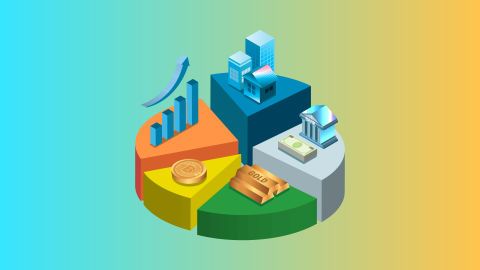To simplify the jargon of intraday trading, let us first understand it. Trading involves stocks, shares, derivatives, currencies, etc. In intraday trading, traders buy and sell shares on the same day. For example, Ritika buys 100 shares of LMD Company at 11 A.M. on 16th September. In intraday trading, she must sell all 100 shares before the market closes that same day, no matter the price.
Intraday trading is typically done to leverage the price instabilities and fluctuations that a particular asset may see in a day. Compared to regular trading, intraday traders try to make the most of the market volatility and book their profits.
Here are some terms you should be aware of:
1. Ask price and bid price
When investors check a stock’s price, they see the most recent trading price. However, when they go to buy or sell that same stock, the price may have changed by then as stock prices fluctuate.
- The ask price is the price at which the seller is ready to sell shares
- The bid price is the price at which the buyer is ready to buy shares
2. Bid-ask spread
The difference between the ask price and the bid price of a particular stock is called the bid-ask spread. It can help you see and understand how much the stock’s price has been fluctuating.
3. Bull and bear markets
Two of the most common terms in the intraday trading vocabulary are bull market and bear market.
- A bull attacks by thrusting its horns upward, representing upward movement. A bull market refers to a period when stock prices are rising or expected to rise, indicating positive investor sentiment. In a bull market, investor confidence is high as demand exceeds supply.
- A bear, on the other hand, swipes its paws downward, reflecting the downward movement. In a bear market, investor confidence is low, and fear or pessimism drives the market.
4. Candlestick charts
For a beginner investor, candlestick charts can be a helpful tool in understanding the otherwise complex pattern of price movements in the market. These charts display bars that look similar to candles of different lengths. The length of the candle, its wick, and its colour all represent the price movements.
5. Margin
Each time a stock is bought or sold, the stock exchange requires the broker to provide a small sum as security for the trade. This amount is called a margin. The broker collects this margin from the trader and deposits it with the exchange as a guarantee.
Buying on margin is another concept where the trader can borrow funds from the broker and make purchases.
6. Trading hours and after hours
Trading hours, as the name suggests, are the working hours, which are from 9:30 A.M. to 4:00 P.M., on weekdays, which are Monday through Friday. The after-hours or pre-market trades are from 4:00 P.M. to 9:30 A.M.
7. Position
In stock trading, position refers to the the commitment of the trader to buy or sell shares on the exchange. When traders buy shares through an intraday buy order, they hold an open buy position, also known as a long position. When traders sell shares through an intraday sell order, they hold an open sell position, also known as a short position.
8. Short selling
Short selling allows traders to sell shares even if they don’t own them in their demat account. Since it's an intraday trade, they must repurchase the shares before the market closes. Traders often short-sell when they expect the stock price to fall during the day, aiming to profit from the price drop.
9. Stop loss
For every intraday trader, be it beginner or seasoned, stop loss is an important tool, as it helps limit losses and manage risk. The idea is to reduce losses by automatically exiting the trade when the stock price hits a predetermined level. It’s an effective way to protect yourself from sudden and unfavourable market movements.
10. 52-week high or low
The 52-week high or low indicates the highest and lowest prices of a security over the past 52 weeks, that is 1 year. It serves as a technical indicator that shows resistance and support levels for traders in their decision-making.
These are some of the most common jargon of intraday trading.








 Food & Beverages
Food & Beverages Fashion
Fashion Beauty & Personal Care
Beauty & Personal Care Health & Wellness
Health & Wellness Home & Kitchen
Home & Kitchen

 Loan Against Shares
Loan Against Shares Loan Against Mutual Funds
Loan Against Mutual Funds Loan Against Bonds
Loan Against Bonds Loan Against Insurance Policy
Loan Against Insurance Policy ESOP Financing
ESOP Financing Two-wheeler Loan
Two-wheeler Loan Loan for Lawyer
Loan for Lawyer Industrial Equipment Finance
Industrial Equipment Finance Industrial Equipment Balance Transfer
Industrial Equipment Balance Transfer Industrial Equipment Refinance
Industrial Equipment Refinance
 Smartphones
Smartphones Air Conditioner
Air Conditioner Led TVs
Led TVs Air Coolers
Air Coolers Refrigerators
Refrigerators Washing Machines
Washing Machines Laptops
Laptops

 Trading Account
Trading Account Open Demat Account
Open Demat Account Margin Trading Financing
Margin Trading Financing Share Market
Share Market Invest in IPO
Invest in IPO All stocks
All stocks Top gainers
Top gainers Top losers
Top losers 52 week high
52 week high 52 week low
52 week low
 Business Loan
Business Loan Secured Business Loan
Secured Business Loan Loan against property
Loan against property Loans against property balance transfer
Loans against property balance transfer Loan against shares
Loan against shares Home Loan
Home Loan Loans against mutual funds
Loans against mutual funds Loan against bonds
Loan against bonds Loan against insurance policy
Loan against insurance policy
 Term Life Insurance
Term Life Insurance ULIP Plan
ULIP Plan Savings Plan
Savings Plan Retirement Plans
Retirement Plans Child Plans
Child Plans Investment Plans
Investment Plans
 Get Bajaj Prime
Get Bajaj Prime
 ULIP Plan
ULIP Plan Savings Plan
Savings Plan Retirement Plans
Retirement Plans Child Plans
Child Plans Free Demat Account
Free Demat Account Invest in IPO
Invest in IPO Invest in Stocks
Invest in Stocks Margin Trading Facility
Margin Trading Facility
 Check your Credit Score
Check your Credit Score
 Bike
Bike Scooter
Scooter Electric Vehicle
Electric Vehicle Best Sellers
Best Sellers Popular Brands
Popular Brands
 New Car Loan
New Car Loan Used Car Loan
Used Car Loan Loan Against Car
Loan Against Car Car Loan Balance Transfer and Top-up
Car Loan Balance Transfer and Top-up
 Engagement Zone
Engagement Zone Game Zone
Game Zone
 Personal Loan EMI Calculator
Personal Loan EMI Calculator Personal Loan Eligibility Calculator
Personal Loan Eligibility Calculator Home Loan EMI Calculator
Home Loan EMI Calculator Home Loan Eligibility Calculator
Home Loan Eligibility Calculator Good & Service Tax (GST) Calculator
Good & Service Tax (GST) Calculator Flexi Day Wise Interest Calculator
Flexi Day Wise Interest Calculator Flexi Transaction Calculator
Flexi Transaction Calculator Secured Business Loan Eligibility Calculator
Secured Business Loan Eligibility Calculator Fixed Deposits Interest Calculator
Fixed Deposits Interest Calculator Two wheeler Loan EMI Calculator
Two wheeler Loan EMI Calculator New Car Loan EMI Calculator
New Car Loan EMI Calculator Used Car Loan EMI Calculator
Used Car Loan EMI Calculator All Calculator
All Calculator
 Hot Deals
Hot Deals Clearance Sale
Clearance Sale Kitchen Appliances
Kitchen Appliances Tyres
Tyres Camera & Accessories
Camera & Accessories Mattresses
Mattresses Furniture
Furniture Watches
Watches Music & Audio
Music & Audio Cycles
Cycles Mixer & Grinder
Mixer & Grinder Luggage & Travel
Luggage & Travel Fitness Equipment
Fitness Equipment Fans
Fans
 Personal Loan for Doctors
Personal Loan for Doctors Business loan for Doctors
Business loan for Doctors Medical Equipment Finance
Medical Equipment Finance Secured Business Loan
Secured Business Loan Loan against property
Loan against property Loan against share
Loan against share Gold Loan
Gold Loan Home Loan
Home Loan
 Smartphones
Smartphones Air Conditioners
Air Conditioners LED TVs
LED TVs Air Coolers
Air Coolers Refrigerators
Refrigerators Washing Machines
Washing Machines Laptops
Laptops Water Purifiers
Water Purifiers Tablets
Tablets Kitchen Appliances
Kitchen Appliances Mattresses
Mattresses Furniture
Furniture Music and Audio
Music and Audio Cameras & Accessories
Cameras & Accessories Cycle
Cycle Watches
Watches Tyres
Tyres Luggage & Travel
Luggage & Travel Fitness Equipment
Fitness Equipment
 Home Loan
Home Loan Transfer your existing Home loan
Transfer your existing Home loan Loan against Property
Loan against Property Home Loan for Salaried
Home Loan for Salaried Home loan for self employed
Home loan for self employed Home Loan EMI Calculator
Home Loan EMI Calculator Home Loan eligibility calculator
Home Loan eligibility calculator Home Loan balance transfer
Home Loan balance transfer
 Offer World
Offer World
 Articles
Articles
 Overdue Payments
Overdue Payments Other Payments
Other Payments
 Document Center
Document Center Bank details & Documents
Bank details & Documents Tax Invoice Certificate
Tax Invoice Certificate
 Do Not Call Service
Do Not Call Service
 Your Orders
Your Orders Hamara Mall Orders
Hamara Mall Orders

 Fixed Deposit (IFA) Partner
Fixed Deposit (IFA) Partner Loan (DSA) Partner
Loan (DSA) Partner Debt Management Partner
Debt Management Partner EMI Network Partner
EMI Network Partner Become a Merchant
Become a Merchant Partner Sign-in
Partner Sign-in
 Food & Shopping
Food & Shopping Credit Card Hub
Credit Card Hub ULIP Plans
ULIP Plans Top Gainers Stock
Top Gainers Stock Top Losers Stock
Top Losers Stock Saving Plan
Saving Plan Term Insurance
Term Insurance
 Live Videos
Live Videos













